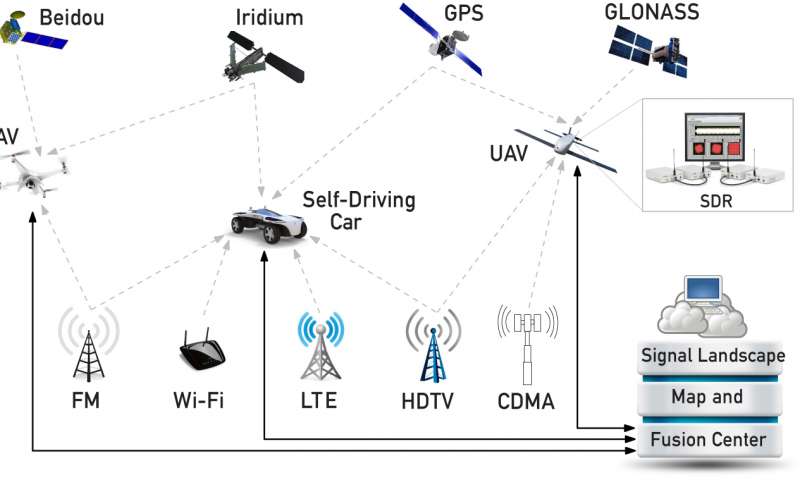Researchers at the University of California, Riverside have developed a reliable and accurate navigation system that exploits existing environmental signals such as cellular and Wi-Fi rather than the Global Positioning System (GPS). The technology can be used as a standalone alternative to GPS, or complement current systems to enable highly reliable, consistent navigation. Additionally, this technology can be used to develop navigation systems that meet the stringent requirements of fully autonomous vehicles, such as unmanned drones or driverless vehicles.

Simulation results for an unmanned drone showing the true trajectory (red) with GPS navigation only (yellow), and GPS aided with cellular signals (blue). Image source: UCR.
Spearheaded by assistant professor of electrical and computer engineering in UCR’s Bourns College of Engineering, Zak Kassas, the team presented its research at the 2016 Institute of Navigation Global Navigation Satellite System Conference in Portland, OR this past September. The two studies, “Signals of Opportunity Aided Inertial Navigation” and “Performance Characterization of Positioning in LTE Systems” both won best paper presentation awards.
Most navigation systems in automobiles and portable electronics use the space-based Global Navigation Satellite System (GNSS), including the U.S. system GPS, Russian system GLONASS, European system Galileo, and Chinese system Beidou. When it comes to precision technologies, such as aerospace and missiles, navigation systems usually combine GPS with a high-quality on-board Inertial Navigation System (INS), which delivers a high level of short-term accuracy but eventually drifts when it loses touch with external signals.
But despite advances in such technology, current GPS/INS systems won’t be able to meet the demands of future autonomous vehicles for a number of reasons. On their own, GPS signals are weak and unusable in certain environments such as deep canyons. They’re also susceptible to intentional and unintentional jamming and interference, and civilian GPS signals are unencrypted, unauthenticated, and specified in publicly available documents, making them hackable.

The schematic shows how UCR researchers are using existing communications signals to complement satellite-based navigation systems such as GPS for the contorl of driverless cars and UAVs. Image source: UCR.
Because of the reasons above, current trends in autonomous vehicle navigation systems rely not only on GPS/INS, but a suite of other sensor-based technologies such as cameras, lasers, and sonar.
“By adding more and more sensors, researchers are throwing 'everything but the kitchen sink' to prepare autonomous vehicle navigation systems for the inevitable scenario that GPS signals become unavailable,” Kassas said. “We took a different approach, which is to exploit signals that are already out there in the environment.”
Instead of adding more internal sensors, Kassas and his team in UCR's Autonomous Systems Perception, Intelligence, and Navigation (ASPIN) Laboratory are developing autonomous vehicles that could tap into the hundreds of signals around us at any point in time, like cellular, radio, television, Wi-Fi, and other satellite signals.
Source: phys.org
Advertisement
Learn more about Electronic Products Magazine





